
Cattleya is a genus of orchids from Costa Rica south to Argentina. The genus is abbreviated C in trade journals.

× Ascocenda, abbreviated as Ascda in the horticultural trade, was a human-made hybrid orchid genus resulting from a cross between the former genus Ascocentrum and Vanda. It was first described in Orchid Rev. 57: 172 (1949). Ascocentrum is now synonymous with Vanda, so the name is obsolete. Hybrids in the nothogenus × Ascocenda are now properly termed Vanda.

Sobralia is a genus of orchids native to Mexico, Central and South America. The plants are more commonly terrestrial, but are also found growing epiphytically, in wet forests from sea level to about 8,800 ft. The genus was named for Dr. Francisco Sobral, a Spanish botanist. The genus is abbreviated Sob in trade journals.

Prosthechea is a genus of flowering plants in the orchid family (Orchidaceae). The name is derived from the Greek word prostheke (appendix), referring to the appendage on the back of the column. Appendage orchid is a common name for this genus. Prosthechea is abbreviated Psh. in the horticultural trade.
× Brassoepidendrum, abbreviated Bepi. in the horticultural trade, is the nothogenus of intergeneric orchid hybrids including wild ancestors from both genera Brassavola and Epidendrum, and from no others.

× Brassolaeliocattleya, abbreviated Blc. in the horticultural trade, is the orchid nothogenus for intergeneric hybrid greges containing at least one ancestor species from each of the three ancestral genera BrassavolaR.Br., CattleyaLindl. and Laelia Lindl., and from no other genera.
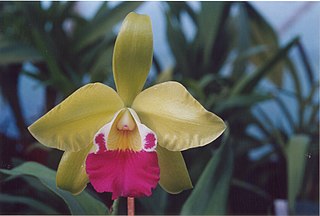
× Epilaeliocattleya, abbreviated Eplc. in the horticultural trade, is the nothogenus consisting of all intergeneric orchid hybrids descended from at least one species in each of the parent genera, and from no other natural genera.
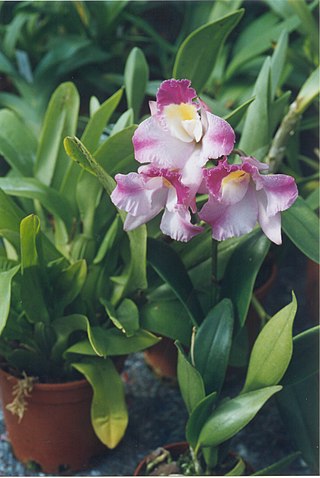
× Laeliocatonia is a nothogenus of intergeneric orchid hybrids descended from the parent genera Laelia, Cattleya and Broughtonia. It is abbreviated Lctna. in the horticultural trade.

Dryadella is a genus of miniature orchids, formerly included in the genus Masdevallia. Plants are typically composed of a tuft of leaves from 3 to 6 cm long. The small (1–2 cm) flowers are often conspicuously spotted, and are borne at the base of the leaves. There are about 60 species, distributed from southern Mexico to southern Brazil and northern Argentina. In cultivation many of the species seem to respond well to being grown on cork or treefern rather than in pots. The attractive species Dryadella edwallii, commonly known as 'Partridge in the Grass' can be easily grown into a spectacular specimen plant, full of flowers. The genus name of Dryadella refers to Dryad, a tree nymph or tree spirit in Greek mythology.

Guarianthe, abbreviated Gur. in the horticultural trade, is a small genus of epiphytic orchids, growing in wet forests in Mexico, Central America, Colombia, Venezuela and Trinidad. It was separated from the bifoliate Cattleyas in 2003, based on phylogenetic studies of nuclear DNA sequence data.

Cycnoches, abbreviated as Cyc. in the horticultural trade, is a genus of 34 currently accepted species of orchids native to South America, Central America and southern Mexico. Also called "swan orchids", they are epiphytes found in lowland and pre-montane forests.

Comparettia, abbreviated Comp in the horticultural trade, is a genus of orchids. It consists about 50-70 species, native to tropical America. They occur in Mexico, Central America, the West Indies, and in northern South America as far south as Brazil and Bolivia, although they are particularly common in the Andes. The genus has grown markedly in recent years due to many species being transferred from other genera.

× Burrageara, abbreviated Burr. in the horticultural trade, is the nothogenus for intergeneric hybrids between the orchid genera Cochlioda, Miltonia, Odontoglossum and Oncidium. It was grown for the first time by the American Albert Burrage in 1927, and named after him.

× Colmanara, abbreviated Colm. in the horticultural trade, is the nothogenus comprising intergeneric hybrids between the orchid genera Miltonia, Odontoglossum and Oncidium.
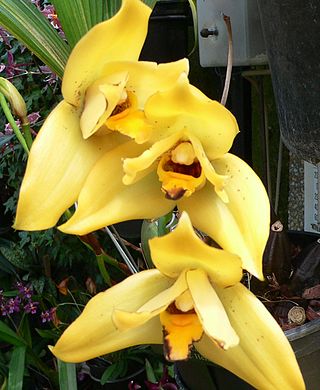
The term grex, derived from the Latin noun grex, gregis, meaning 'flock', has been expanded in botanical nomenclature to describe hybrids of orchids, based solely on their parentage. Grex names are one of the three categories of plant names governed by the International Code of Nomenclature for Cultivated Plants; within a grex the cultivar group category can be used to refer to plants by their shared characteristics, and individual orchid plants can be selected and named as cultivars.
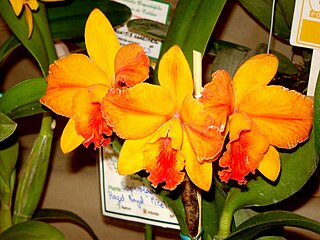
× Cattlianthe, abbreviated Ctt. in the horticultural trade, is the orchid nothogenus for intergeneric hybrid greges containing at least one ancestor species from each of the two ancestral genera Cattleya and Guarianthe, and from no other genera.

× Laeliocatarthron, abbreviated Lcr. in the horticultural trade, is the nothogenus containing intergeneric hybrids with at least one ancestor in each of the natural genera Cattleya, Caularthron, and Laelia, and with no ancestors in any other natural genera.
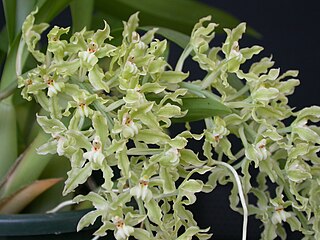
Gomesa is a genus of flowering plants from the orchid family, Orchidaceae. It contains about 80–100 species, all native to South America. The genus is abbreviated as Gom.
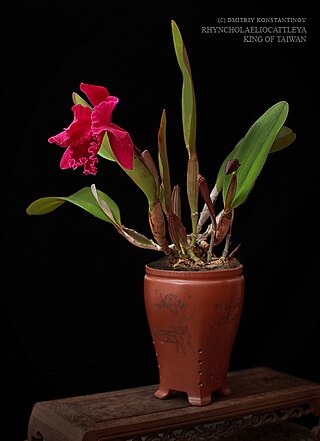
× Rhyncholaeliocattleya, abbreviated Rlc. in the horticultural trade, is the orchid nothogenus for intergeneric hybrid greges containing at least one ancestor species from each of the two ancestral genera RhyncholaeliaSchltr. and CattleyaLindl., and from no other genera.

Cattleya × elegans is a hybrid orchid in the subtribe Laeliinae. It is a pseudobulb epiphyte. Its formula hybridae is Cattleya purpurata Van den Berg (2008) × Cattleya tigrina A.Rich. (1848). It is found in South and South-East Brazil.



















